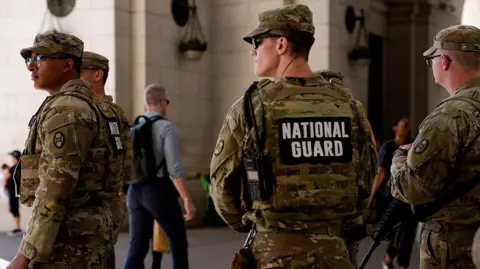 Getty Images
Getty ImagesPresident Donald Trump’s deployment of the National Guard to several US cities has drawn a round of legal challenges by state and local officials.
Trump argues that his use of the troops is necessary to quell violence in Democratic-controlled cities, crack down on crime and support his deportation initiatives.
He has found himself on a collision course with several Democratic state governors, who have resisted these efforts, and who say the deployments are unnecessary and risk escalating tensions. Legal cases have recently been filed in Illinois and Oregon.
As the legal battles continue, here’s what to know.
What is the National Guard and who oversees it?
The National Guard consists of primarily state-based troops that typically respond to major issues like natural disasters or large protests.
All 50 US states, the District of Columbia, and the territories of Guam, Puerto Rico, and the US Virgin Islands have their own contingent of National Guard troops. Those troops also can be deployed abroad, and some units specialise in fighting wildfires or securing the US border.
Guard members ultimately report to the Department of Defence, and can be federalised – or brought under the control of the president – under certain circumstances. However, requests for its support normally start at a state level.
In those circumstances, the governor of a state activates guard troops during an emergency, and can request additional help from the president or other states.
National Guard troops have limited power. They do not enforce the law, or make arrests, seizures, or searches. A law called the Posse Comitatus Act limits the power of the federal government to use military force for domestic matters.
How is Trump trying to use the National Guard in US cities?
Trump has tried to circumvent the normal process for deploying the National Guard several times now – including with his efforts to order guard members from one state into a different state.
In June, he took control of the California National Guard to respond to protests against immigration raids in Los Angeles, even though Governor Gavin Newsom objected.
California filed two cases against the Trump administration. One of these challenged Trump’s seizure of the National Guard, but an appeals court ultimately ruled in favour of the president. In a second case, a federal judge found that Trump’s use of the guard troops in Los Angeles violated the Posse Comitatus Act.
Over the summer, hundreds of National Guard troops were sent into Washington DC, to respond to what Trump called a “situation of complete and total lawlessness”. The president cited homelessness and crime rates as justification.
Trump has now authorised the deployment of 300 guard members to Chicago following immigration protests, particularly outside detention facilities. Officers who were sent from Texas have now arrived at a training centre near Chicago.
Illinois Governor JB Pritzker, a Democrat, has alleged Trump is trying to “manufacture a crisis”, and has filed a legal case of his own.
Trump also attempted to deploy National Guard members from other states to Portland, in Oregon, before a federal judge temporarily blocked him.
What legal basis does Trump use to deploy the National Guard?
A little-known provision of US military law governs the president’s authority to deploy the National Guard on his own. Until now, presidents have rarely used it.
American law allows the president to call National Guard troops from any state into service if the US is “invaded or is in danger of invasion by a foreign nation”, or “there is a rebellion or danger of a rebellion” against the US government.
Trump invoked this law to bring 2,000 National Guard troops under his control in June in order to support raids led by Immigration and Customs Enforcement (ICE).
Defence Secretary Pete Hegseth also cited the law in a memo deploying 200 members of the Oregon National Guard into federal service on 28 September.
“We’re very confident in the president’s legal authority to do this,” White House press secretary Karoline Leavitt told reporters on 6 October. “And we’re very confident we will win on the merits of the law.”
Why does Trump want to use the National Guard in Portland?
Trump is again seeking to use the National Guard to respond to demonstrations, after protests near an ICE building in Portland in early October.
Federal officers, including with the Department of Homeland Security (DHS) and Customs and Border Patrol agency (CBP), clashed with demonstrators who opposed Trump’s mass deportation initiative.
Trump has claimed the city is “burning down,” but Oregon Governor Tina Kotek, a Democrat, said “there is no insurrection in Portland, no threat to national security.”
The Trump administration has moved to send 200 California National Guard troops to neighbouring Oregon to respond to the protests. But US District Judge Karin Immergut, who Trump appointed during his first term, has temporarily blocked this.
On Saturday, Judge Immergut blocked Trump from federalising the Oregon National Guard. “This is a nation of constitutional law, not martial law,” she wrote in her ruling. The next day, she issued a temporary restraining order against Trump deploying California’s National Guard in Portland instead.
The Trump administration is expected to appeal.
